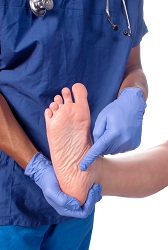Heel spur

Heel Pain
It is estimated that 10% of Americans suffer from heel pain. The most common cause of heel pain is plantar fasciitis and ranks #3 on the list of most common running-related injuries. This is what led Groucho Marx to remark, “Time wounds all heels.” Fortunately, effective treatments for heel pain are available and 85% of patients improve without surgery after 3 months.
Heel Spur
Bone spurs can form along the bottom or back of the heel bone. These bone spurs can cause pain if shoe or the ground press against them. These spurs can weaken the attachment of the plantar fascia or the Achilles tendon to the heel bone (calcaneus). Once heel spurs form, they do not go away unless they are surgically removed. In many cases, inflammation around the spur causes more pain than the spur itself. Consequently, treatment of the inflammation can often lead to a resolution of the pain in-spite of the heel spur. However, in some cases the fascia or tendon become damaged and scarred near the tendon (fasciosis or tendinosis).
Treatment
The primary focus in treating a bone spur is to resolve inflammation or heal damage to the surrounding soft tissue. This can include the plantar fascia or Achilles tendon. If the pain resolves without removing the spur, then the spur is left alone. This is termed an asymptomatic heel spur. When pain at the site of bone spur does not resolve, the spur may need to be removed. An emerging treatment option for damaged soft tissue around the heel spur is to inject material into the site which improves healing of the soft tissue. This includes PRP or amnion injections into the soft tissues around a bone spur. Although cortisone is effective in reducing inflammation, it does not dissolve a bone spur. In addition, there are side-effects from the use of cortisone near large tendons. Typically, cortisone is contraindicated for Achilles tendonitis and heel spurs on the back of the heel.
This information is not intended to diagnose, treat, or prevent any injury or disease. It is intended to serve as an overview of running-related injuries and should not be used as a substitute for sound medical advice from a doctor or therapist.


